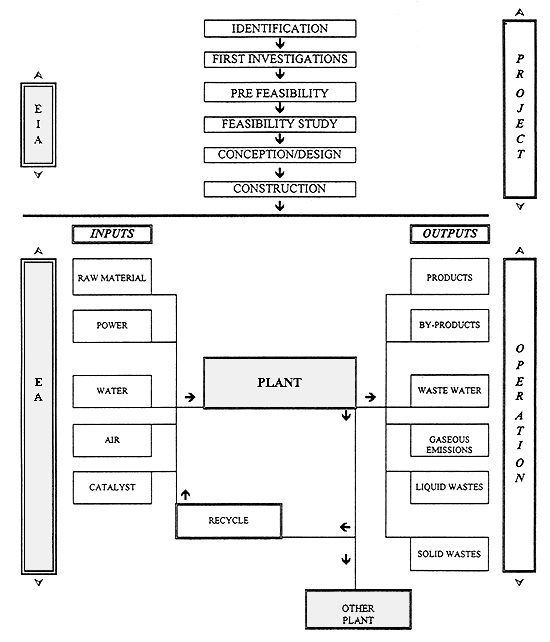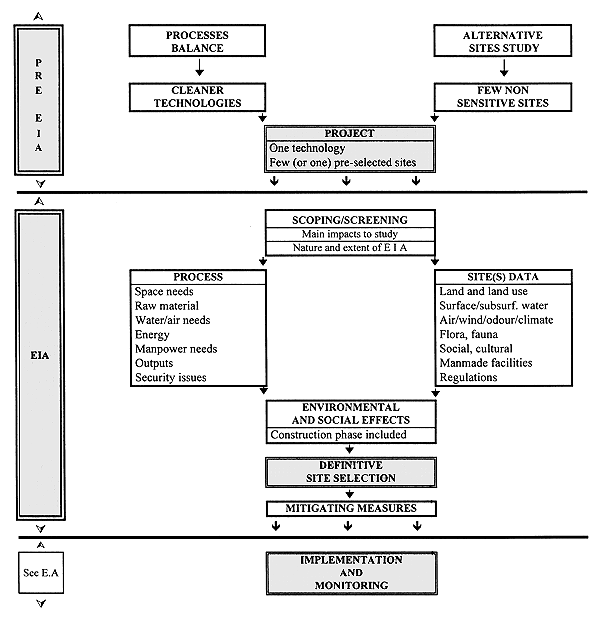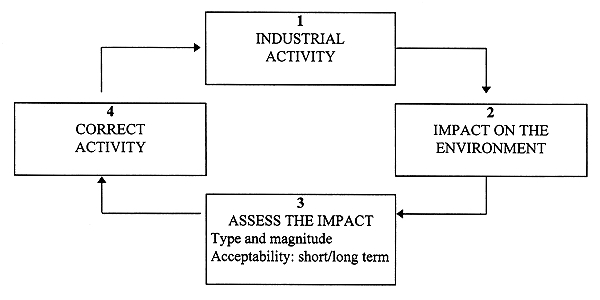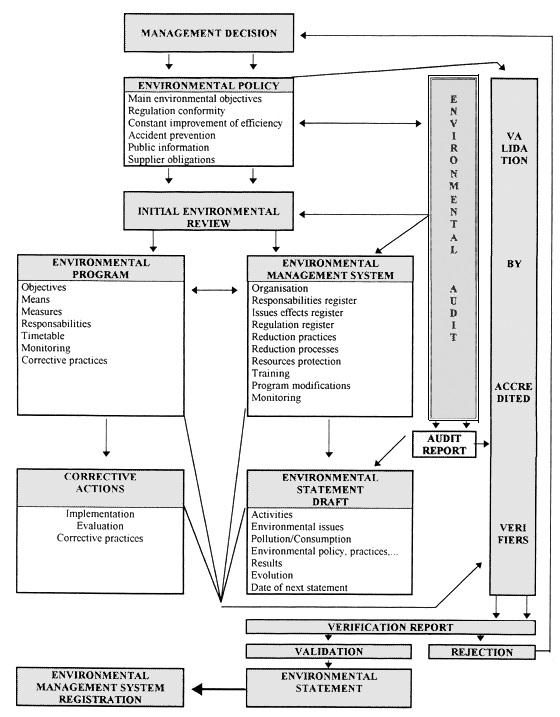EIA goals
Environmental Impact Assessment is a tool designed to identify and predict the impact of a project on the bio-geophysical environment and on man's health and well-being, to interpret and communicate information about the impact, to analyze site and process alternatives and provide solutions to sift out, or abate/mitigate the negative consequences on man and the environment.
EIA is always necessary for a pulp and paper project (whether it is a new mill or the expansion of an existing facility), as for any industrial project of importance. The EIA is a means of avoiding environmental disturbances that are always much more expensive to correct after their occurrence than before. It is also important to underline that very few projects have been deemed not viable merely because of the cost of pollution control and that modern environmental control, in a new plant, is less than 3% of the initial investment.
Today, there is world-wide evidence that man cannot ignore the quality of the environment. Thus environmental issues must be addressed as soon as possible during project planning. There should not be any hesitation in abandoning a project or a process at an early stage, or in proposing alternatives to any project which would have very detrimental impact on the environment, as is the case for projects which are not economically or financially viable. In the same way as economic, financial, institutional, or technical analyses, EIA is an integral part of the project.
Aware of this necessity, numerous countries have implemented EIA regulations. International agencies generally also lend their assistance to any industrial project of importance implementing an EIA, including pulp and paper industries.
EA goals
Environmental Auditing (or Audit) is a management tool used by industry to evaluate its environmental performance. Contrary to EIA, an EA is only implemented in processing sites.
The definition of the EA describes precisely the goals of this environmental tool. As written in the “Environmental Auditing Technical Report of UNEP/IEO”, an EA is : “A management tool comprising a systematic, documented, periodic and objective evaluation of how well environmental organization, management and equipment are performing in the aim of helping to safeguard the environment by :
Facilitating management and control of environmental practices,
Assessing compliance with company policies, which would include meeting regulatory requirements”.
UNEP/IEO add, in summary, “EA should provide answers to the following questions raised by company managers :
It is also important to note that an EA cannot stand alone and must be integrated in an overall management system and must include dialogue between the plant manager and people living in the vicinity.
Executive summary :
In a few pages it allows anyone (specialist or not) to understand the different repercussions of the project (on the environment, human well-being and safety) and to be informed of the alternatives chosen and the mitigating measures that have to be implemented.
Project description, and legal and administrative framework :
A brief description of the project is necessary with all off-site extensions and their interaction with natural and social components. All the regulations implemented within the EIA must be detailed here.
Scoping and screening :
It is important that people in charge of the protection of the environment (ministries, borrowers, donors, NGOs, associations, inhabitants…) can outline to the investor the limits of the EIA, in time, space and the type of impact to be addressed (as well as the way of evaluating them), and identify the alternatives.
Description of the existing environment :
Precise data relevant to the site is required, describing: intended uses, quality, physical, biological, social, and economic conditions. This description must include other existing or proposed developments. The use of maps, graphs, drawings… is very important for a better understanding of the situation. Key data gaps and uncertainties must be identified here.
Analysis of alternatives and basis for the selection of the alternative proposed:
The project description (see paragraph 2 above) is completed by a precise description of the different choices concerning processes, site and all alternatives that the investor has examined for a better protection of the environment and populations concerned. A comparison of these different alternatives, in term of their potential impact and cost/benefit analysis, is required. The basis on which each alternative is chosen must be stated.
Environmental issues of the project:
Once the project is defined and all alternatives thoroughly studied, this section presents the environmental issues around the final project. Each area of positive or negative impact must be defined in terms of its magnitude, reversibility, period of occurrence and nature (primary, secondary…). At this stage it is important to outline in detail the different phases of the project and to address all the environmental repercussions linked with each phase. All the drastically negative repercussions that cannot be eliminated must be identified and mitigating measures must be proposed in the next chapter.
Mitigating measures:
For all remaining negative repercussions, mitigating measures have to be proposed (and must be undertaken as soon as the project starts). These measures must be realistic both technically and economically. The efficiency of each measure in reducing significant negative effects to an acceptable level must be assessed. An estimation of the required investment is necessary at this stage to verify the feasibility of the proposed measures.
Environmental management and training and environmental monitoring plan:
In order to try and prevent environmental accidents, it is necessary to prepare a document to define the role of each person or group in the environmental management team of the future company and the monitoring and training procedures undertaken to enhance the capabilities of the staff and workers. These documents will naturally be updated once the plant is built.
Appendices:
All documents needed for understanding the chosen methodology, the references, the meetings with ministries, scientists, managers, affected groups, the names and qualifications of the authors of the study, need to appear under this heading.
There are many kinds of audit which can be conducted alone or not. The audit can be concentrated on organization, emission, compliance with standards and regulation, maintenance, security, material balance, training, outside contractors…
The International Chamber of Commerce presents the different steps of an EA as follows:
Pre-audit activities: which include:
Contact with facility and planning of the audit.
Site activities: which are divided into 5 steps:
Report of findings to facility.
Post audit activities: which include:
Figure 6 shows the details of each step.
It is important to notice that the audit system is a cycle. Its periodicity has to be defined previously and the site control phase periodicity must not exceed 3 years.
The EIA takes place as soon as possible in the project development, and at the latest during the feasibility study. The different development possibilities and the EIA become more and more precise as the project proceeds. When the project design is complete the EIA can be produced and submitted in its final version. The EA is conducted only in operating sites.
Figure 2 shows the place of each “tool” in the project cycle.
Figure 2: Project cycle and timing of the EIA and EA (Source: Brèche)

The EIA follows the project but it has its own requirements. Figure 3 shows the EIA cycle and its conception. Chapter 3 proposes a precise description of each phase of an EIA for a pulp and paper project.
Figure 3 : Environmental Impact Assessment cycle (Source BRECHE)

The contents of the EIA and the range of studies to be implemented, in order to make predictions on environmental issues, are directly linked to the size of the project and to the sensitivity of the area where it is to be erected. The EIA must provide the decision makers and the population with all the necessary analytical data, for their information and awareness. As superfluous details are unprofitable, the assessment has to pinpoint the important parameters to be studied, the others are only mentioned. For these major parameters, it is often necessary to follow some guidelines in order to have as objective a thinking as possible. Though this may not be necessary for small projects where good practice of EIA and common sense can be sufficient, it is a necessity for large scale projects principally when they include integrated forest development. There are various methods available to guide the EIA author. Three are be detailed here:
Various check-lists, or EIA type methods, are available world-wide. Generally check-lists are more widely used in developing countries while EIA type methods are often used in developed countries by authorities to guide the EIA authors in their thinking.
The principle of these two methods is to give a framework to EIA authors so that they do not forget any important point. Check-lists, or EIA type methods, are good tools but they cannot take into consideration all particular cases that can be met during an EIA. However, they are generally sufficient for small scale projects. These methods can be combined with the use of environmental guidelines, widely proposed by authorities or donors agencies.
While EIA type methods are available for different activities, check-lists are provided both for various sectors of activity (industries, forestry, agriculture…) and for the different types of areas affected (wetlands, tropical forests, coastal zones…).
Some examples of check-lists are provided both in the appendices and in the next chapter dedicated to EIA in the pulp and paper industry.
The Leopold matrix is the best known matrix methodology available for predicting the impact of a project on the environment.
It is a two dimensional matrix cross-referencing:
The activities linked to the project are listed on one axis: raw material production, building construction, water supply, energy supply, raw material preparation, pulp and paper mills processing, gaseous emissions, liquid effluents, cooling water discharges, noise, solid wastes treatment and disposal, transportation.
The environmental and social conditions are listed on the other axis, and divided in three major groups:
The Leopold matrix proposes a three-step process to estimate the impact:
First step :
for all the interactions considered significant by the authors, the first step is to mark the corresponding boxes in the matrix with a diagonal line.
Second step :
once the boxes with supposed significant interactions are slashed, the author evaluates each box by applying a number from 1 to 10 (1 is the minimum and 10 the maximum) to register the magnitude of the interaction. This number is transferred to the upper left hand corner. It represents the scale of the action and its theoretical extent.
Third step :
the final step for this method is to mark (from 1 to 10), in the lower right hand corner, the real importance of the phenomenon for the given project. It then gives an evaluation of the extent of the environmental impact according to the assessor's judgement.
Once the matrix is established the EIA gives a precise description of each important impact in the matrix (with the larger numerical values for magnitude and importance). The discussion must also address columns and rows with large numbers of interactions. They show activities, or elements, in connection with the environment which are particularly significant or sensitive.
The Leopold matrix proposes a framework for all developers but, on one hand, it is too detailed for pulp and paper projects, and on the other not precise enough for such projects. It is generally more efficient to accommodate it as needed and to develop a customized matrix for the project. An example of a possible matrix for the pulp and paper industry is given in figure 4.
Figure 4 : Example of matrix for the pulp and paper industry (Leopold method).
Evaluation method | A C T I O N | ||||||||||||||
|---|---|---|---|---|---|---|---|---|---|---|---|---|---|---|---|
| RAW MATERIAL PRODUCTION | BUILDING OPERATIONS | WATER SUPPLY | ENERGY SUPPLY | RAW MATERIAL PREPARATION | INDUSTRIAL PROCESSES | GASEOUS EMISSIONS | LIQUID EFFLUENTS | COOLING WATER DISCHARGES | SOLID WASTES TREATMENT | TRANSPORTATIONS | TOTAL | ||||
| ENVIRONMENTAL / SOCIAL CONDITIONS | PHYSICAL | SOIL | SOIL QUALITY | ||||||||||||
| EROSION | |||||||||||||||
| GEOMORPHOLOGY | |||||||||||||||
| WATER | RIVERS | ||||||||||||||
| COASTAL ZONE | |||||||||||||||
| SUBSURFACE WATER | |||||||||||||||
| SEA QUALITY | |||||||||||||||
| AIR | AIR QUALITY | ||||||||||||||
| ODOURS | |||||||||||||||
| NOISE | |||||||||||||||
| BIOLOGICAL | FLORA | FORESTS | |||||||||||||
| CROPS | |||||||||||||||
| WETLANDS | |||||||||||||||
| SEA-GRASSES | |||||||||||||||
| RIVER FLORA | |||||||||||||||
| FAUNA | MAMMALS | ||||||||||||||
| BIRDS | |||||||||||||||
| FISH | |||||||||||||||
| OTHERS VERTEBRATES | |||||||||||||||
| INVERTEBRATES | |||||||||||||||
| ECOSYSTEMS | ECOSYSTEMS QUALITY | ||||||||||||||
| ECOSYSTEMS DESTRUCTION | |||||||||||||||
| SOCIAL | LAND USES | RURAL | |||||||||||||
| FISHERIES | |||||||||||||||
| URBAN | |||||||||||||||
| INDUSTRIAL | |||||||||||||||
| RECREATIONAL USES | |||||||||||||||
| PATRIMONY | LANDSCAPE | ||||||||||||||
| HISTORICAL/CULTURAL | |||||||||||||||
| HERITAGE | |||||||||||||||
| WILDERNESS QUALITY | |||||||||||||||
| SOCIAL | POPULATION DENSITY | ||||||||||||||
| EMPLOYMENT | |||||||||||||||
| HAZARDS | |||||||||||||||
| TOTAL | |||||||||||||||
First designed for water resource development, the Battelle method can easily be used in other projects. The principle lies in splitting the environmental impacts in four major categories: ecology, pollution, aesthetics and human interest. These categories are divided into thematic data as shown :
Ecology
Ecosystems.
Pollution
Noise pollution.
Aesthetics
Composition.
Human interest
These thematic data are divided into environmental indicators. For example in the pulp and paper industry, water pollution could be represented by : BOD, dissolved oxygen, faecal coliforms, inorganic carbon, pH, temperature, total dissolved solids, turbidity, etc.
Once the environmental indicators are chosen, the method follows three steps:
First step :
at this stage, the goal of the method is to transform environmental indicators into environmental quality. The notation table defines a number from 0 to 1 (0 for poor quality and 1 for good quality). Thus it is possible to quantify evolution both in the wrong or right direction (environmental deterioration or improvement).
Second step :
a total of a 1,000 points (or Parameter Importance Units : PIU) are shared among the indicators by the authors of the EIA. They reflect the relative importance of each parameter.
Third step :
the comparison between the situation with and without the project is done in Environmental Impact Units (EIU). It can even reflect benefits or losses in terms of environmental conditions.

Where :
(Vi)1 environmental quality for indicator “i” in the project conditions,
(Vi)2 environmental quality for indicator “i” without the project,
wi relative weight of the indicator “i” (PIU),
m total number of indicators.
The principal advantage of this method is that it gives a comparative analysis between several situations, thus it is particularly efficient when effecting choices between alternatives.
Some software is available to help in forecasting the impact of development projects. FAO proposes a software package “Ecozone” which is not specific to the pulp and paper industry but includes the analysis of possible impacts of a project for 6 types of ecozones :
| - Upland humid, | Upland arid, |
| - Lowland humid, | Lowland arid, |
| - Coastal humid, | Coastal arid. |
for five groups of activities: agriculture, aquaculture, forestry, livestock and water resources.
The software is a package which consists of the following programmes :
Ecozone-Impacts. Contains pre-programmed rules and facts about the environmental impact of development projects, and may be used to indicate the major potential environmental impact of certain development activities in different regions of the tropics. In addition, an encyclopaedia of textual information about regions, sectors, activities, and environmental impact of activities is provided.
Ecozone-Workshop. Contains facts in its textual database, but does not hold any rules about environmental impact and projects. It was designed for use in specific training situation, where groups of trainees enter their own rules about the environmental impact of activities in different sectors. The programme automatically combines the rules of the different groups, allowing the rules of all the groups to interact. In this way it is possible to show how an activity can have negative or positive impacts which may affect other activities.
Ecozone-Control and Empty book. Ecozone-Empty book contains no facts or rules, it is an empty shell of the Ecozone-Impact system. Its purpose is to allow very experienced users to enter new rules and facts about, for example, a particular country, region or activity. Ecozone-Control book simply allows users to create and access new Empty books.
Ecozone-Impacts allows to determine automatically the major impacts of a development project. The impacts are classified in terms of primary or higher order impacts. For example: Deforestation increases run-off which induces soil erosion which leads to increased sedimentation, etc.
Ecozone-Workshop allows us to determine the impact of a project alone. It is generally better to begin the experience by filling Ecozone-Workshop and then to compare the results with those of Ecozones-Impacts.
Ecozone-Empty book allows to create its own database of projects: for example pulp and paper projects.
This chapter will show the organization of environmental management in any industry. The first cycle (figure 5) to consider is the cycle of the relationship between industry and environment, and between environmental management and industry.
Figure 5 : Industry and environment relationship. (Source: Environmental auditing at Ciba Geigy)

Environmental Auditing takes place in the third phase of the cycle and leads to the fourth phase to adapt the activity to environmental requirements.
According to the International Chamber of Commerce EA can have many benefits such as :
To lead to those benefits a precise methodology has to be followed. We reproduce here (Figure 6) the proposed methodology of the International Chamber of Commerce in the technical report of UNEP/IEO: Environmental Auditing.

EA can also be integrated in an overall environmental management system (EMS). Figure 7 synthesizes the EMS proposed by European Union.
Figure 7 : ENVIRONMENTAL MANAGEMENT SYSTEM (SOURCE : METHOD EUROPEAN UNION, DRAWING BRECHE)
